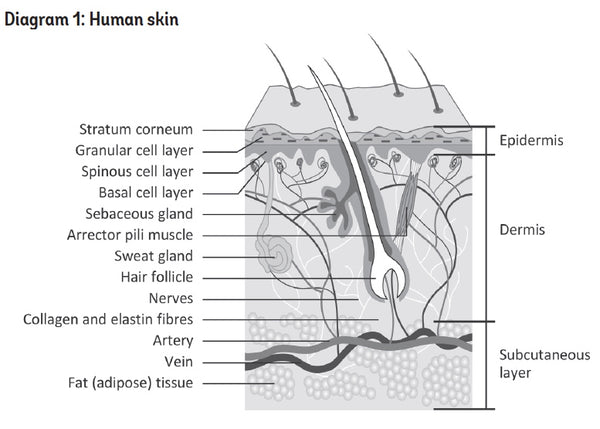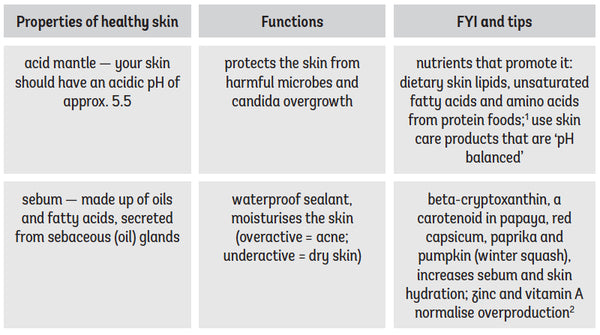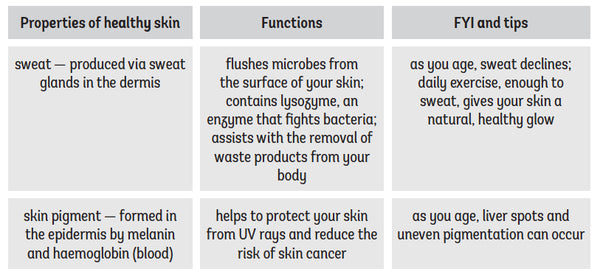
Beautiful skin is a blessing that you take for granted when you are young. It’s your largest organ (and the most visible one) and you walk around clothed in it every day of your life. So it helps if you like how your skin looks and feels.
Then you grow up, and ageing happens. The skin becomes drier, bumpier and wrinkles appear.
However, instead of giving up looking after yourself once you reach a certain age, now is the time to step up your health and skin care routine, because healthy, younger-looking skin is more than just a pretty façade …
Skin Facts
- Your skin acts as a barrier and a filter between the outside world and your insides and it protects your body from invading microbes.
- It helps to regulate your body temperature so you don’t overheat and accidentally cook your internal organs.
- The skin plays an active role in the immune system, helping to protect you from diseases, bacteria and viruses.
- The skin plays a role in vitamin D production to help you maintain bone health.
- The skin can reveal early signs of nutritional deficiencies and indicate that a change in your diet is necessary.
Your skin performs a wide range of important body functions and it plays a vital role in keeping you alive so it pays to look after it. And with today’s research and technology it’s easier than ever before to keep your skin looking younger for years to come.
Let’s take a closer look at your skin as it gives us valuable clues on how to look after it...
The Epidermis
The epidermis is the outer (or dead) layer of your skin. It is thinnest on your eyelids at .05 mm (1/1000 in) and thickest on your palms and soles at approximately 1.5 mm (3/50in).
The epidermis itself contains five layers, which are mostly made up of cells that produce keratin, a tough and fibrous protein that forms a protective layer.
The column-shaped cells in the bottom layer push cells into higher layers — this skin-renewing trip takes about 28 days.
The top layer of the epidermis, the stratum corneum (or skin barrier), is made of flat, dead cells that shed about every 2 weeks.
Skin facts
- Every 40 minutes your skin sheds about 1 million dead skin cells, and over a lifetime you’ll shed enough skin to fill a bath.
- Between the ages of 30 and 80, the skin’s cell turnover rate decreases by 30 to 50% (but you can increase this with the right skin care routine).
- New skin cells form at the bottom of the epidermis and when they’re ready they move towards the stratum corneum. In normal, healthy skin this trip takes about 4 weeks.
When the epidermis layer of your skin is functioning properly, the following youth-preserving properties are at optimal levels:
Loss of elasticity in the skin
Interlocking finger-like waves join the epidermis to the dermis, which is the deeper layer of the skin. This important junction allows nutrients and oxygen to travel from the inner layers to the outer layer of the skin so it stays healthy.
When hormone levels such as oestrogen decline, the finger-like junctions flatten and nutrient exchange slows, causing loss of elasticity in the skin. However, no matter what your hormones are doing (or not doing) daily exercise can help to manually improve blood flow to the surface of your skin.
Deeper skin layer
The deeper layer of the skin is the dermis. It’s like the soil in a garden, situated below the surface with the all-important jobs of maintaining the skin’s structure and supplying nutrients and fluids.
The dermis is a thick layer containing bundles of collagen fibres and coarse elastic fibres made of elastin, which enable the skin to stretch and return to its original shape. The dermis also contains sweat glands, hair follicles, veins and hyaluronic acid which attracts and holds water.
Wrinkles appear when changes occur to the deeper layers of the dermis. When the dermis is functioning properly, the following four youth-preserving properties are at optimal levels.
Collagen
Collagen is like the glue that keeps your skin together. It’s an amazing protein structure in the skin that twines in a triple rope-like formation, called a helix, so it is extra strong and durable — on a per weight basis collagen is nearly as strong as steel.
More than one-third of collagen is made up of the amino acid glycine, another third is proline and a small proportion consists of lysine and other amino acids. These amino acids are found in protein-containing foods such as fish, eggs, meats, beans, nuts and seeds.
For healthy collagen production in the skin, your diet needs to be rich in protein, vitamin C, iron, zinc and manganese. As you age, there is a reduction in collagen fibres, especially in the upper dermis.
Elastin
If you were to pick up an elastic band and stretch it around a jar and then later take it off, the elastic band would snap back into its original shape and size. The elastic fibres within your dermis should also stretch up to 150 per cent of their relaxed length without breaking, then return to their original shape.
Elastin is a protein found within coarse elastic fibres in the dermal layer of the skin, which branch together to give the skin strength and flexibility.
Like a lycra swimsuit that loses tautness over time, your skin can lose some of its elasticity during the ageing process.
Hyaluronic acid for healthy skin
In normal skin, glycosaminoglycans (GAGs) such as hyaluronic acid are found between collagen and elastic fibres in the dermal layer. Hyaluronic acid is also found in the epidermis of younger skin but disappears as you age.
- It is hydrophilic, which means it attracts water, which protects collagen and elastin from becoming rigid.
- Smoking cigarettes decreases the amount of hyaluronic acid in your body.
You can increase hyaluronic acid naturally by supplying its main building block, glucosamine, in your diet. Magnesium and zinc are also needed to manufacture hyaluronic acid. It’s thought that traditional societies who age well do so because their traditional diet, rich in root vegetables, supplies plenty of magnesium and zinc for hyaluronic acid production.
Nutrient-rich blood supply for healthy skin
A healthy blood supply to the skin gives your complexion an attractive, healthy glow. The bloodstream carries oxygen and nutrients to the skin for maintenance, repair and building of new skin cells.
As you age, the walls of blood vessels in the dermis become thicker and more rigid, and if your diet (or your digestion) is poor, your skin may not receive enough nutrients. The first indicator is a dull complexion and over time problems such as skin abnormalities, premature ageing and poor wound healing (and skin ulcers in the case of diabetes) can occur.
Subcutaneous layer of the skin – the cushioning
Beneath the dermis lies the subcutaneous layer, which contains fat cells. Your fat cells provide cushioning and insulation to protect the body and plump the skin so it looks younger.
As you age, these fat cells get smaller in areas such as the face, and if you are thin your face can age faster because you have fewer fat stores to pad your skin and minimise the appearance of wrinkles.
In areas such as the thighs, bottom and stomach, the opposite can occur. The subcutaneous layer thickens (predominantly in women) so fat cells protrude into the dermis and can cause the appearance of cellulite.
Skin messengers
Your endocrine system, comprised of your hormones and glands, is heavily involved in the ageing process. The endocrine system produces and regulates hormones, which can drastically decline as you age. Hormones are used to regulate growth, mood, metabolism, sexual and reproductive function, and collagen production in the skin, to name a few.
Oestrogens are the main sex hormone in women and they’re present in small amounts in men. Oestrogens increase glycosaminoglycans (GAGs) such as hyaluronic acid, which softens and hydrates the skin and helps to maintain structural quality (which is why women have softer skin than men).
Oestrogens have anti-inflammatory properties and they play a role in the network of collagen and elastin in your skin, helping to increase collagen production and promote healthy hair.
This is an edited extract from:
Photo: Brigitte Bardot suffered from eczema when she was a teenager.
Diagrams and tables are from Younger Skin in 28 Days and are the property of Karen Fischer and Exisle Publishing.
References







 Nothing will be posted on your behalf.
Nothing will be posted on your behalf.

